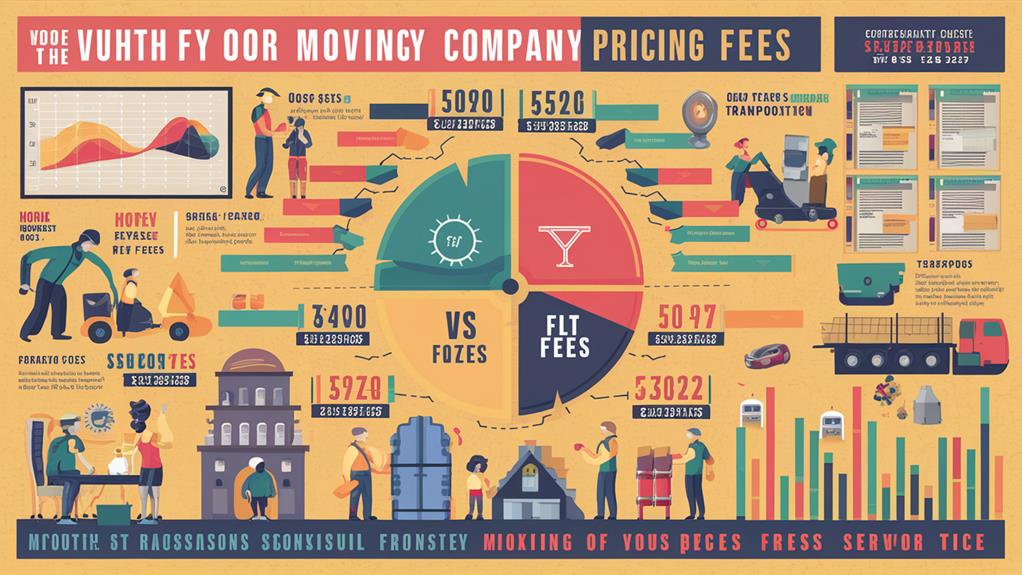When you're comparing moving company pricing models, you'll find several options. Hourly rate pricing charges based on the time taken and is great for local moves. Flat rate pricing offers a fixed fee, making budgeting easier but needs careful review to avoid extra charges. Weight-based pricing, common for long-distance moves, depends on how much your belongings weigh, while distance-based pricing considers mileage. Each option has pros and cons, so it's crucial to assess your move's specifics and watch for hidden fees. By examining these models closely, you can choose the best one for your needs and budget.
Importance of Understanding Moving Costs

Understanding moving costs is vital to ensuring a smooth relocation. When you know what to expect, it helps you budget effectively. Local moves typically average between $800 to $3,000, while long-distance moves can range from $3,000 to over $15,000. Being aware of these figures can prevent unwelcome surprises.
Additionally, it's important to keep in mind that common hidden fees such as packing supplies and temporary storage can significantly impact your overall expenses.
Different pricing models, like hourly rates and flat-rate pricing, play a significant role in determining your total expenses. By grasping these concepts, you can make informed decisions tailored to your specific needs.
It's also essential to factor in additional costs, such as packing and storage fees, which can quickly add up.
Understanding moving means recognizing that hidden fees may lurk in contracts, so it's crucial to read the fine print. You should also consider factors like the distance of the move, the size of your belongings, and seasonal pricing that may affect costs.
Overview of Pricing Models
When it comes to moving, selecting the right pricing model can significantly affect your overall costs and experience. There are several pricing models offered by moving companies to compare, each designed for different needs. The most common are hourly rate pricing, flat rate, weight-based pricing, and distance-based pricing.
Understanding the nuances of moving cost breakdown can help you make an informed decision. Hourly rate pricing charges you based on the time taken for the move. This is often best for smaller moves but can get pricey for larger jobs.
Flat rate pricing provides a set fee for the entire moving process, offering predictability in costs. However, it's important to review the terms to avoid unexpected additional fees.
Weight-based pricing calculates costs based on the actual weight of your belongings, typically used for long-distance moves. This method can be tricky, as estimating the total weight beforehand may not always be accurate.
Distance-based pricing, on the other hand, is generally applied for interstate moves, where costs depend on the mileage between your current and new locations.
Understanding these pricing models helps you get accurate quotes and prepares you for the total cost of your move.
Fixed Price Model Explained

The fixed price model gives you a clear cost for your move, making it easy to budget without worrying about surprise charges.
This approach works best for simple relocations, where you can plan everything without the hassle of unexpected expenses.
Additionally, understanding key moving cost factors can help you better assess whether the fixed price model is suitable for your situation.
Just remember to read the fine print to understand what's included and if there might be any extra fees.
Predictable Cost Structure
Navigating the world of moving can be daunting, but the fixed price model simplifies things by offering a predetermined fee for your entire relocation. This predictable cost structure allows you to know your total expenses upfront, making budgeting easier.
With this model, you won't have to stress over unexpected costs that can pop up with other pricing methods.
To get an accurate fixed price, a detailed evaluation of your move is necessary. Factors like distance, size, and any special items you may have will be considered to determine the cost.
While this model is beneficial for straightforward moves, it's essential to understand that it may not always reflect the actual effort or resources needed, especially for more complex relocations.
Before committing, make sure to review the terms of the fixed price agreement carefully. This will help you understand what's included and avoid surprises like additional charges.
Choosing a reliable moving company that offers a fixed price model can provide peace of mind, ensuring you stay within your budget while enjoying a smoother moving experience.
Ideal for Simple Moves
A fixed price model shines for simple moves, making it an appealing choice for those looking for a straightforward relocation experience. This pricing structure provides a predetermined fee for the entire move, allowing you to plan effectively and avoid stress.
It's ideal for simple moves that don't involve complicated logistics or a large number of items, ensuring you won't face unexpected costs during the moving process.
With a fixed price model, most quotes include all necessary services, giving you clarity on what you're paying for. You can easily budget your expenses without worrying about hourly fluctuations or additional charges.
However, it's essential to carefully review the terms of your fixed price agreement. Make sure to account for any potential extra charges, like additional items or services not included in the base fee.
While this model offers great transparency, it may not reflect the actual effort needed for more complicated moves. Therefore, it's best suited for those with straightforward relocation needs.
Hourly Rate Model Insights
Understanding the nuances of the hourly rate model can help you make informed decisions during your move. This pricing approach charges you based on the actual time taken for your move, and it can vary depending on the complexity and size of your project.
Typically, hourly rates range from $80 to $150 per hour, which includes labor, truck rental, and necessary equipment. These rates may change based on your location and the company you choose.
The hourly rate model is ideal for local moves or smaller projects, allowing for flexibility in scheduling. However, it's essential to be aware that longer or more complicated moves can lead to significantly higher costs, as the price accumulates with each hour.
To avoid unexpected overages, obtaining a written estimate beforehand is crucial. This helps you understand anticipated costs, ensuring you're prepared for the moving process.
Weight-Based Pricing Details

When it comes to moving, weight-based pricing can significantly impact your budget. This pricing model determines your moving costs by calculating the total weight of your belongings. Typically, moving companies weigh the truck before and after loading to get an accurate measure. For interstate moves, the average cost per pound can range from $0.50 to $2.00, depending on the company and the distance involved.
Weight-based pricing is especially effective for moves that include heavy items, as it ensures you're billed fairly based on the actual load. To enhance cost-effectiveness, it's advisable to declutter before moving. Minimizing lightweight, bulky items can help reduce the overall weight, saving you money in the process.
It's also important to ask about weight charges and any additional fees related to weight-based pricing. This will help you avoid unexpected expenses during the moving process.
Factors Influencing Moving Costs
Several key factors can drive up your moving costs, making it essential to consider them ahead of time.
First, the distance of your move plays a significant role. Longer distances usually mean higher transportation expenses due to fuel and time factors.
Next, the size and weight of your belongings are crucial; larger or heavier items require more resources, labor, and truck space, directly impacting the total cost.
Seasonal pricing is another important factor. Moving during peak seasons, like summer, often results in higher rates compared to off-peak times when demand is lower.
Additionally, if you choose extra services—like packing, unpacking, or storage—these can lead to additional charges that need to be included in your overall budget.
Lastly, consider the accessibility of the properties involved in your move. Challenges such as stairs, narrow doorways, or long carries can increase labor charges, further affecting your final expenses.
Steps to Obtain Accurate Quotes

Obtaining accurate quotes from moving companies is essential for budgeting your relocation effectively.
To ensure you receive the best estimates, follow these steps:
- Create a Comprehensive Inventory: List all items you plan to move. This helps movers assess your needs and provides tailored quotes based on your inventory.
- Request In-Home Estimates: Invite moving companies to your home for accurate assessments. This allows them to see what needs to be moved and helps avoid surprises on moving day.
- Gather Quotes from Different Companies: Collect multiple quotes from reputable moving companies. Compare rates and included services to find the most cost-effective option based on your budget and needs.
- Read the Fine Print: Carefully review each estimate for hidden fees or additional services. Look for charges related to packing, storage, or special handling to avoid unexpected costs later.
Choosing the Right Pricing Model
Choosing the right pricing model for your move can significantly impact your overall experience and budget. Start by assessing the specific characteristics of your move, like size, distance, and any special handling needs. This helps you determine whether an hourly rate or a flat rate is most cost-effective for you.
Comparing quotes from multiple moving companies is crucial. You'll often find different pricing models available, which can help you identify which aligns best with your budget and requirements. Be vigilant about potential hidden costs. Review each pricing model's terms closely, especially regarding additional services like packing or storage.
Understanding the pros and cons of each model can guide you in making informed decisions. For instance, a flat rate offers predictability in overall cost, while an hourly rate provides flexibility, depending on how quickly your move goes.
Always utilize written estimates to clarify included services and pricing structures. This ensures you select a model that meets your expectations without unexpected charges. By taking these steps, you'll transition smoothly into your new home, confident that you've chosen the right pricing model for your needs.
Conclusion
In conclusion, understanding moving company pricing models is essential for making informed decisions. By exploring fixed price, hourly rate, and weight-based pricing, you can determine which model fits your needs best. Remember to consider factors that influence costs and follow steps to get accurate quotes. This knowledge will help you budget effectively and choose the right moving service. With careful planning, you can make your move smoother and less stressful.
